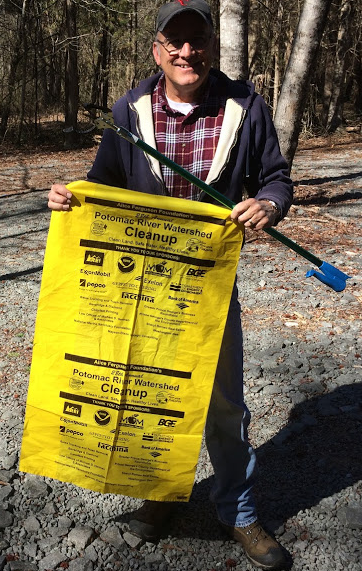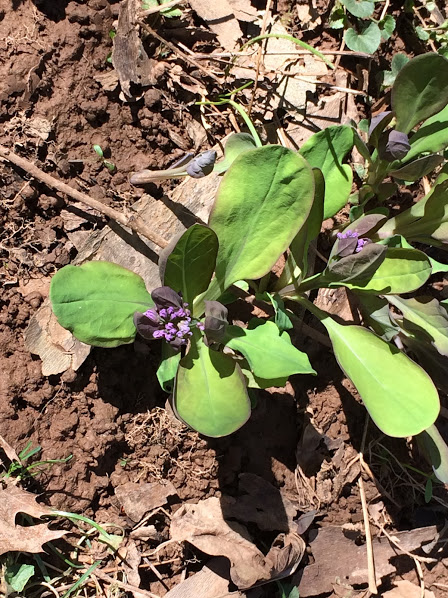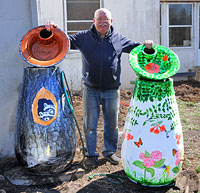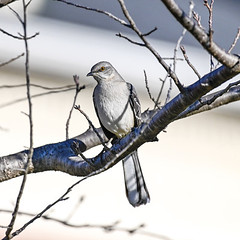Archive for the ‘Merrimac Farm WMA’ Category
Renewing the “Adoption” of Cedar Run
 As part of the mission of the Prince William Conservation Alliance “to explore, enjoy, and protect our natural areas, and increase community involvement in stewardship opportunities,” we recently renewed our commitment to adopt the reach of Cedar Run adjacent to Merrimac Farm.
As part of the mission of the Prince William Conservation Alliance “to explore, enjoy, and protect our natural areas, and increase community involvement in stewardship opportunities,” we recently renewed our commitment to adopt the reach of Cedar Run adjacent to Merrimac Farm.
We partner with the Prince William Soil and Water Conservation District. It has an “Adopt-a-Stream” program, where volunteers agree to a two-year commitment to clean litter from a stream segment.
Many of PWCA’s members and friends recognize Cedar Run as the stream whose fertile flood plain provides the home for the beautiful bluebells and other wildflowers that flourish there.
We’ve already done our first clean-up for the year. We’re happy to report the litter along Cedar Run’s banks and floodplain has been removed.
As of February 27, the bluebells were already popping up, getting ready for the April 8 Bluebell Festival!
Stay tuned for opportunities to help keep Cedar Run clean, just one small way PWCA demonstrates our commitment to protect watersheds in Prince William County.

Spring is just around the corner!
Thanks to hard working volunteers, we’re looking forward to a spring that is bursting with blooms at Merrimac Farm! Join us on 3/14 and more to help keep up the good work … the schedule is online at http://www.pwconserve.org/events/
Nature Notes – Merrimac Farm April 29, 1012
by Harry Glasgow
 On the last Sunday of every month, the Prince William Conservation Alliance sponsors a nature walk at the Merrimac Farm Wildlife Management Area in Nokesville. This morning, we walked this very beautiful remote property and tallied 38 species.
On the last Sunday of every month, the Prince William Conservation Alliance sponsors a nature walk at the Merrimac Farm Wildlife Management Area in Nokesville. This morning, we walked this very beautiful remote property and tallied 38 species.
Of particular interest were Warblers. We found an abundance of Prairie Warblers, and what could almost be called a flock of Hooded Warblers along the area’s Cedar Run Trail, which provided the greatest concentration.
A Louisiana Waterthrush, one of the Hooded Warblers, and the Magnolia provided the best views, while the others were heard rather than seen.
White-eyed Vireos were very plentiful, as were Red-eyed Vireos, Barred owls, and even a few Wood Thrushes. It was a beautifully cool and bright morning for a walk deep in the woods. The full list is below the fold and the preliminary bird list for Merrimac Farm is online here. Continue reading
Bluebell Festival a Hit!
 This year’s annual Bluebell Festival at Merrimac Farm (and my first) on April 15, turned out to be a great experience even though the famous bluebells were past their peak due to the unseasonably warm weather. As such, there was a greater focus on wildlife and history.
This year’s annual Bluebell Festival at Merrimac Farm (and my first) on April 15, turned out to be a great experience even though the famous bluebells were past their peak due to the unseasonably warm weather. As such, there was a greater focus on wildlife and history.
Several hundred participants, including many families with children, arrived in a steady stream throughout the day. Once greeters mentioned that Alvin the albino corn snake was available for petting, the children made a direct beeline for his enclosure.
“I got to hold him. He’s cool!” said 7-year-old Jason. Dad nodded in agreement, but Mom wasn’t so enthusiastic. Continue reading
Merrimac Farm Spring Work Day
 Spring is here a little early and Prince William Conservation Alliance members kicked it off with another fun and productive volunteer work day at the Merrimac Farm landscape conservation project and the Stone House.
Spring is here a little early and Prince William Conservation Alliance members kicked it off with another fun and productive volunteer work day at the Merrimac Farm landscape conservation project and the Stone House.
Last Saturday (3/10/2012), volunteers tore down the old fascia boards on the front porch of the house and put up new fascia. New rain gutters were also installed.
In the back in the conservation project, trenches were dug for the corrugated flex pipe that was laid to connect the two rain barrels that were set up; there will be a third rain barrel installed in the coming weeks. The water collected in the rain barrels will be used to water the plantings in the landscape project.
The native plants that were planted last October easily survived the mild winter. Serviceberry, coneflower, wild ginger and columbine are already sending out new green shoots. During the course of the work, a bald eagle was spotted conducting a flyover of the farm. Continue reading
Nokesville Christmas Bird Count
 Together a team of nearly 30 volunteers recorded 81 species at the Nokesville Christmas Bird Count on December 26 2011 (species list below the fold). Previous counts ranged from 82 species in 2008 to 86 species in 2009.
Together a team of nearly 30 volunteers recorded 81 species at the Nokesville Christmas Bird Count on December 26 2011 (species list below the fold). Previous counts ranged from 82 species in 2008 to 86 species in 2009.
Some species seen previous years were noticeably absent, including Red-breasted Nuthatches, Purple Finches, Horned Larks and Bobwhite. Sadly the Brewers Blackbirds, known to frequent a farm on Fleetwood, were nowhere in sight.
Highlights of the day include 12 bald eagles seen at the Prince William County landfill. The Bald Eagles were watching/hunting the 1000+ gulls, mostly ring-billed, foraging through uncovered trash. One Raven was also seen at the landfill, with 2 others at MCB Quantico and 2 in Fauquier County.
A Screech Owl was in Fauquier County along with Barred Owls, which were also seen at Merrimac Farm. Woodcock were seen at MCB Quantico and in Fauquier County. There were many Eastern Bluebirds, with an impressive flock of 50+ at the Rte 234 Wetland Mitigation Area. Continue reading
Going Native! Part II
Merrimac Farm a model for homeowners to emulate
 In my last blog, I explained how going native – homeowners using native plants to replace some or all of their lawn – was beneficial to the environment, and listed a couple of web sites with ideas to help them get started.
In my last blog, I explained how going native – homeowners using native plants to replace some or all of their lawn – was beneficial to the environment, and listed a couple of web sites with ideas to help them get started.
Today’s focus is on a program right here in Prince William County that can provide homeowners with information, ideas, and hands-on experience in working with native plants.
Prince William Conservation Alliance has begun a conservation landscape project at Merrimac Farm, a 302-acre Wildlife Management Area located in Nokesville. It includes more than 100 acres of contiguous wetlands protected by 200 acres of hardwood forests and upland meadows, at the headwaters of the Occoquan Reservoir.
Yesterday (9/24), more than a dozen enthusiastic volunteers gathered for a work day to spread compost in preparation for the first planting day on October 15. Continue reading
Bugs are our friends: Green Lacewing
If you have seen a pale gr een, almost translucent insect with golden eyes, either flying around or perched on a leaf, it’s probably a Green Lacewing. These delicate creatures are harmless, but their larvae are voracious predators, devouring soft-bodied pests such as mealy bugs, scale, spider mites, caterpillars, whitefly, leafhoppers, pest eggs and aphids.
een, almost translucent insect with golden eyes, either flying around or perched on a leaf, it’s probably a Green Lacewing. These delicate creatures are harmless, but their larvae are voracious predators, devouring soft-bodied pests such as mealy bugs, scale, spider mites, caterpillars, whitefly, leafhoppers, pest eggs and aphids.
The female lays 200 or more eggs on a plant leaf and stem, each suspended on a hair-like stalk. After several days, the eggs hatch, and the larvae feed insatiably on insect pests. One lacewing larva can eat as many as 600 aphids during the 1 to 4 weeks before it pupates. After about 5 days in the pupal stage, an adult lacewing emerges. The Green Lacewing in this photo was found at Merrimac Farm.
You can help create an environment where lacewings thrive. A garden with flowers will attract adults, who survive primarily on nectar and pollen. Lacewings like high humidity, which is the norm for our Virginia summers. They also need a place to overwinter, under loose mulch, leaf litter or under rocks. As you can see, you don’t have to do much to provide the proper habitat for the Green Lacewing, and you will be amply rewarded with a natural solution to your insect pest problem.
A Goldfinch Kind of Day
Today I completed my second monthly “Four Hour Walk” which is like the popular photowalk, but I’m by myself instead of with a group of photographers and I’m in a wildlife management area, Merrimac Farm, instead of in a city or town. Hurricane Irene had passed through the area during the night, so I wasn’t sure if I would find any damage or flooding. Fortunately there was none of either.
My last Four Hour Walk was so much fun that I have decided to make it a monthly exercise. This second time turned out to be somewhat frustrating, but fun none the less. I had decided to take a four foot computer controlled camera slider along with three cameras, tripod, video monitor, and my regular bag of lenses and accessories. Dumb.
Walking through the woods with this much gear makes it all but impossible to get shots of birds and other animals during the fleeting seconds that they stay in range. I missed getting a shot of a beautiful Great Blue Heron as well as a small herd of white tail deer.
More frustrating was all the goldfinches. The area around the Stone House is known for always having a lot of songbirds around. (Can you imagine how great it will be when the Conservation Landscape Project is completed?) Today it must have been goldfinch day. With all of the thistles in full bloom, the birds were plentiful and active. So why is the only photo I have of them the poor image above? Continue reading
 Leave a comment
Leave a comment
